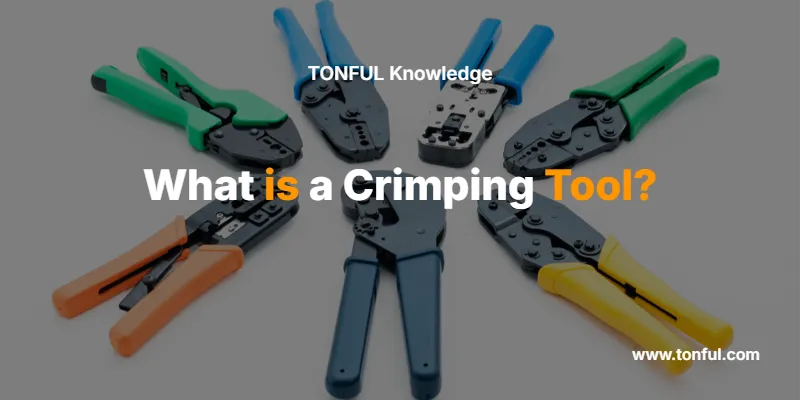A crimping tool is a specialized hand tool designed to join two pieces of metal or other materials by deforming one or both pieces to hold them together securely. You use crimping tools primarily for electrical connections, where they create permanent, gas-tight joints between wires and terminals, connectors, or other wires without requiring soldering or welding.
Quick Answer: Crimping tools compress metal sleeves, terminals, or connectors onto wires to create secure electrical connections. They’re essential for professional electrical work, automotive wiring, networking, and DIY electrical projects.
What Makes a Crimping Tool Different from Other Connection Methods?
Crimping creates mechanical connections through controlled deformation, offering several key advantages over alternatives:
| Connection Method | Durability | Speed | Skill Required | Equipment Cost | Reversibility |
|---|---|---|---|---|---|
| Crimping | Excellent | Fast | Moderate | Low-Medium | No |
| Soldering | Excellent | Slow | High | Medium | Difficult |
| Wire Nuts | Good | Fast | Low | Very Low | Yes |
| Screw Terminals | Good | Medium | Low | Low | Yes |
| Push-in Connectors | Fair | Very Fast | Very Low | Medium | Sometimes |
Expert Tip: Properly crimped connections often outlast the wire itself and meet or exceed the electrical and mechanical properties of the original conductor when done correctly.
Types of Crimping Tools: Complete Comparison Guide

1. Manual Crimping Tools
Hand-Operated Crimpers are the most common type for general electrical work:
| Feature | Basic Hand Crimper | Ratcheting Crimper | Professional Grade |
|---|---|---|---|
| Price Range | $10-30 | $25-75 | $100-500+ |
| Wire Gauge | 22-10 AWG | 22-8 AWG | Custom ranges |
| Force Applied | Manual only | Mechanical advantage | Calibrated pressure |
| Consistency | Variable | Good | Excellent |
| Best For | Light DIY work | Regular use | Professional applications |
2. Hydraulic Crimping Tools
Hydraulic crimpers provide maximum force for heavy-duty applications:
- Cable Capacity: Up to 750 MCM (thousand circular mils)
- Operating Pressure: 10,000+ PSI
- Applications: Power distribution, industrial wiring
- Weight: 15-50 pounds depending on capacity
3. Battery-Powered Crimping Tools
Cordless electric crimpers offer speed and consistency:
- Crimping Speed: 3-7 seconds per connection
- Battery Life: 200-500 crimps per charge
- Force Control: Automatic pressure regulation
- Cost Range: $300-2,000+
4. Specialized Crimping Tools
| Tool Type | Primary Use | Wire Range | Key Features |
|---|---|---|---|
| Coax Crimpers | Cable TV, networking | RG6, RG59, RG11 | Hex crimp dies, compression fittings |
| Modular Crimpers | Phone, ethernet | Cat5e, Cat6, Cat6a | 8P8C, 6P6C connectors |
| Automotive Crimpers | Vehicle wiring | 22-10 AWG | Weatherproof terminals |
| Insulation Displacement | Networking patches | Solid core only | No wire stripping needed |
Key Applications and Use Cases
Electrical and Electronics Applications
Residential Wiring Projects:
- Installing ceiling fans and light fixtures
- Connecting junction boxes and outlets
- Automotive electrical repairs
- Audio/video system installations
Commercial and Industrial Uses:
- Panel wiring and control circuits
- Motor connections and power distribution
- Telecommunications and networking
- Renewable energy system installations
Automotive Applications
Vehicle Electrical Systems:
- Battery terminal connections
- Trailer wiring harnesses
- Custom audio system installations
- Repair of damaged wire connections
⚠️ Safety Warning: Always disconnect battery power before crimping automotive connections to prevent shorts and potential fire hazards.
How to Choose the Right Crimping Tool: Selection Criteria
1. Determine Your Wire Gauge Requirements
Common Wire Gauge Ranges:
- Light duty (22-18 AWG): Automotive accessories, small electronics
- Medium duty (16-12 AWG): Household wiring, appliance connections
- Heavy duty (10-4 AWG): Service panels, motor connections
- Industrial (2 AWG and larger): Power distribution, welding cables
2. Consider Terminal and Connector Types
| Terminal Style | Crimping Requirements | Common Applications |
|---|---|---|
| Ring terminals | Standard hex crimp | Grounding, motor connections |
| Spade terminals | Open barrel crimp | Quick disconnects |
| Butt connectors | Inline crimp | Wire splicing |
| Pin terminals | Precise crimp depth | Automotive connectors |
3. Evaluate Build Quality Features
Professional-Grade Indicators:
- Ratcheting mechanism: Ensures complete crimp cycle
- Calibrated dies: Consistent crimp dimensions
- Ergonomic handles: Reduces hand fatigue
- Replaceable dies: Extends tool life
- Force adjustment: Accommodates different materials
Step-by-Step Crimping Process
Proper Crimping Technique in 7 Steps
- Select correct terminal size for your wire gauge
- Strip wire to proper length (usually 1/4″ to 3/8″)
- Insert wire fully into terminal barrel
- Position terminal in correct crimping die
- Squeeze handles firmly until ratchet releases (if equipped)
- Inspect crimp quality for proper compression
- Test connection with gentle pull test
Expert Tip: A properly crimped connection should show slight barrel deformation with no wire pullout under moderate tension.
Quality Control Checklist
- ✅ Wire inserted to proper depth
- ✅ No exposed copper visible
- ✅ Terminal not cracked or split
- ✅ Crimp centered on terminal barrel
- ✅ No wire strands protruding
- ✅ Connection passes pull test
Common Crimping Mistakes and How to Avoid Them
Critical Errors That Compromise Safety
| Mistake | Problem | Solution |
|---|---|---|
| Under-crimping | Loose connection, high resistance | Use ratcheting tool, proper force |
| Over-crimping | Damaged wire, brittle connection | Calibrate tool pressure |
| Wrong terminal size | Poor connection, overheating | Match AWG to terminal rating |
| Insufficient wire strip | Poor electrical contact | Follow manufacturer strip length |
| Mixed metals | Galvanic corrosion | Use compatible materials |
⚠️ Safety Alert: Poor crimps can cause overheating, arcing, and fire hazards. When in doubt, cut off the connection and re-crimp with proper technique.
Professional Standards and Compliance
Industry Codes and Standards
National Electrical Code (NEC) Requirements:
- Article 110.14: Connection integrity standards
- Article 300.13: Mechanical continuity requirements
- UL Listed terminals and connectors required for most applications
Automotive Standards:
- SAE J1128: Automotive wire specifications
- SAE J2196: Crimp terminal performance requirements
- ISO 8092: Road vehicle connector standards
Certification and Training
Professional Crimping Certifications:
- IPC/WHMA-A-620: Cable and wire harness assemblies
- IES-CB-2001: Crimp connection standard
- Company-specific certifications for aerospace/military
Quick Reference Guide: Crimping Tool Selection Chart
| Application | Tool Type | Wire Range | Budget Range | Key Features |
|---|---|---|---|---|
| DIY Home Projects | Basic hand crimper | 22-10 AWG | $15-40 | Simple, lightweight |
| Automotive Work | Ratcheting crimper | 22-10 AWG | $30-80 | Weather-resistant terminals |
| Professional Electrical | Professional ratchet | 22-4 AWG | $100-300 | Calibrated, replaceable dies |
| Industrial/Commercial | Hydraulic/Battery | 4 AWG-750 MCM | $500-2000+ | High force, precision control |
| Networking/Telecom | Modular crimper | Cat5e/6/6a | $25-150 | RJ45, RJ11 compatibility |
Frequently Asked Questions About Crimping Tools
What should you look for when buying your first crimping tool?
Start with a ratcheting hand crimper that handles 22-10 AWG wire. Look for replaceable dies, comfortable grips, and compatibility with standard terminals. Expect to spend $40-80 for a quality tool that will last years.
Can you reuse a crimped connection?
No, crimped connections are permanent. Once crimped, the terminal is mechanically deformed and cannot be safely reused. Always cut and replace if you need to modify the connection.
What’s the difference between crimping and soldering electrical connections?
Crimping creates mechanical connections through compression, while soldering uses melted metal alloy. Crimping is faster, requires less skill, and often produces more reliable connections in vibration-prone applications like automotive use.
How do you know if a crimp connection is good?
A quality crimp shows slight barrel deformation, passes a gentle pull test, has no exposed copper, and maintains the wire’s current-carrying capacity. Professional applications may require specific crimp height measurements.
What wire gauges can most crimping tools handle?
Standard hand crimpers typically handle 22-10 AWG wire, covering most residential and automotive applications. Specialized tools can crimp everything from 30 AWG (tiny electronics) to 750 MCM (industrial power).
Are expensive crimping tools worth the investment?
For occasional DIY use, a $40-60 ratcheting crimper is sufficient. Professional electricians benefit from $100-300 tools with calibrated dies and consistent pressure. The investment pays off in reliability and speed.
Can you crimp aluminum wire with standard tools?
Aluminum wire requires special terminals and often different crimping pressures due to the metal’s properties. Always use aluminum-rated terminals and verify your tool’s compatibility before crimping.
What safety precautions should you take when crimping?
Always de-energize circuits before working, wear safety glasses, ensure proper ventilation, and follow NEC guidelines. Never attempt to crimp energized connections, and always test completed work.
Professional Recommendations and Next Steps
When to Call a Professional
Situations requiring licensed electricians:
- Service panel connections
- High-voltage applications (over 600V)
- Code-compliance inspections required
- Unfamiliar with local electrical codes
Building Your Crimping Tool Collection
Progressive Investment Strategy:
- Start with: Quality ratcheting hand crimper ($50-80)
- Add next: Specialized connectors for your most common applications
- Upgrade to: Professional-grade tools as volume increases
- Consider: Battery-powered tools for high-volume work
Expert Recommendation: Invest in quality dies and terminals rather than just focusing on the tool itself. Poor-quality terminals will create unreliable connections regardless of your crimping tool quality.
Remember: Proper crimping technique and quality components are essential for electrical safety. When working on critical systems or unfamiliar applications, consult with qualified professionals to ensure code compliance and safety standards.

